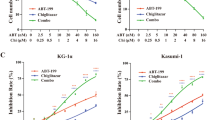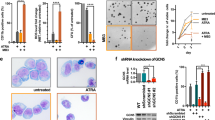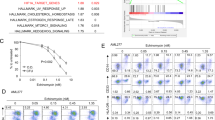Abstract
According to a hierarchical model, targeting leukemia-initiating cells (LICs) was speculated to achieve complete remission (CR) or cure. Nonetheless, increasing evidence emphasized the plasticity of differentiated blasts undergoing interconversion into LICs. We exploited murine models of acute promyelocytic leukemia (APL), a subtype of acute myeloid leukemia driven by the promyelocytic leukemia/retinoic acid receptor (PML-RARα) oncofusion protein, which recruits histone deacetylase (HDAC)-containing complexes. We studied APLs with different LIC frequencies and investigated the effect of two HDAC inhibitors: valproic acid (VPA), with relative selectivity towards class I HDAC enzymes and vorinostat/suberoylanilide hydroxamic acid (SAHA) (pan-HDAC inhibitor) in combination with all-trans retinoic acid (ATRA), on the bulk APL cells and APL LICs. Indeed, we found that while VPA differentiates the bulk APL cells, SAHA selectively targets LICs. ATRA + VPA + SAHA combination efficiently induced CR in an APL model with lower LIC frequency. Substituting ATRA with synthetic retinoids as etretinate which promotes APL differentiation without downregulating PML/RARα compromised the therapeutic benefit of ATRA + VPA + SAHA regimen. Altogether, our study emphasizes the therapeutic power of co-targeting the plasticity and heterogeneity of cancer –herein demonstrated by tackling LICs and bulk leukemic blasts - to achieve and maintain CR.
This is a preview of subscription content, access via your institution
Access options
Subscribe to this journal
Receive 12 print issues and online access
$259.00 per year
only $21.58 per issue
Buy this article
- Purchase on Springer Link
- Instant access to full article PDF
Prices may be subject to local taxes which are calculated during checkout



Similar content being viewed by others
Data availability
The RNA-Seq datasets generated in this study have been deposited in NCBI’s Gene Expression Omnibus and are accessible through GEO Series accession number GSE196379.
References
Visvader JE, Lindeman GJ. Cancer stem cells: current status and evolving complexities. Cell Stem Cell. 2012;10:717–28.
Thomas D, Majeti R. Biology and relevance of human acute myeloid leukemia stem cells. Blood. 2017;129:1577–85.
Ng SWK, Mitchell A, Kennedy JA, Chen WC, McLeod J, Ibrahimova N, et al. A 17-gene stemness score for rapid determination of risk in acute leukaemia. Nature. 2016;540:433–7.
Leiva M, Moretti S, Soilihi H, Pallavicini I, Peres L, Mercurio C, et al. Valproic acid induces differentiation and transient tumor regression, but spares leukemia-initiating activity in mouse models of APL. Leukemia. 2012;26:1630–7.
Chaffer CL, Brueckmann I, Scheel C, Kaestli AJ, Wiggins PA. Normal and neoplastic nonstem cells can spontaneously convert to a stem-like state. PNAS. 2011;108:7950–5.
Thankamony AP, Saxena K, Murali R, Jolly MK. Cancer stem cell plasticity – a deadly deal. Front Mol Biosci. 2020;7:1–16.
Rowe RG, Daley GQ, North TE, Marion W, Pikman Y, Harris MH, et al. Mechanisms of leukemia stem cell plasticity revealed by single cell analysis. Blood. 2020;136:32.
Alcalay M, Zangrilli D, Fagioli M, Pandolfi PP, Mencarelli A, Cocof F Lo, et al. Expression pattern of the RARalpha-PML fusion gene in acute promyelocytic leukemia. PNAS. 1992;89:4840–4.
Insinga A, Monestiroli S, Ronzoni S, Carbone R, Pruneri G, Appella E, et al. Impairment of p53 acetylation, stability and function by an oncogenic transcription factor. EMBO J. 2004;23:1144–54.
Grignani F, De Matteis S, Nervi C, Tomassoni L, Gelmetti V, Cioce M, et al. Fusion proteins of the retinoic acid receptor-alpha recruit histone deacetylase in promyelocytic leukemia. Nature. 1998;391:815–8.
Matsushita H, Scaglioni PP, Bhaumik M, Rego EM, Cai LF, Majid SM, et al. In vivo analysis of the role of aberrant histone deacetylase recruitment and RAR α blockade in the pathogenesis of acute promyelocytic leukemia. J Exp Med. 2006;203:821–8.
Matthews GM, Mehdipour P, Cluse LA, Falkenberg KJ, Wang E, Roth M, et al. Functional-genetic dissection of HDAC dependencies in mouse lymphoid and myeloid malignancies. Blood. 2015;126:2392–403.
Nasr R, Guillemin M, Ferhi O, Soilihi H, Peres L, Berthier C, et al. Eradication of acute promyelocytic leukemia-initiating cells through PML-RARA degradation. Nat Med. 2008;14:1333–42.
Ablain J, Leiva M, Peres L, Fonsart J, Anthony E, de Thé H. Uncoupling RARA transcriptional activation and degradation clarifies the bases for APL response to therapies. J Exp Med. 2013;210:647–53.
Lehmann-Che J, Bally C, Letouzé E, Berthier C, Yuan H, Jollivet F, et al. Dual origin of relapses in retinoic-acid resistant acute promyelocytic leukemia. Nat Commun. 2018;9:1–8.
Lancet JE, Moseley AB, Coutre SE, Deangelo DJ, Othus M, Tallman MS, et al. A phase 2 study of ATRA, arsenic trioxide, and gemtuzumab ozogamicin in patients with high-risk APL (SWOG 0535). Blood Adv. 2020;4:1683–9.
Hu Y, Smyth G. ELDA: Extreme limiting dilution analysis for comparing depleted and enriched populations in stem cell and other assays. J Immunol Methods. 2009;347:70–8.
Abdel-Aziz AK, Pallavicini I, Ceccacci E, Meroni G, Saadeldin MK, Varasi M, et al. Tuning mTORC1 activity dictates the response of acute myeloid leukemia to LSD1 inhibition. Haematologica. 2020;105:2105–211.
Kim D, Pertea G, Trapnell C, Pimentel H, Kelley RSS. TopHat2: accurate alignment of transcriptomes in the presence of insertions, deletions and gene fusions. Genome Biol. 2013;14:0–9.
Fujita PA, Rhead B, Zweig AS, Hinrichs AS, Karolchik D, Cline MS, et al. The UCSC genome browser database: Update 2011. Nucleic Acids Res. 2011;39:876–82.
Li H, Handsaker B, Wysoker A, Fennell T, Ruan J, Homer N, et al. The Sequence Alignment/Map format and SAMtools. Bioinformatics. 2009;25:2078–9.
Quinlan AR, Hall IM. BEDTools: a flexible suite of utilities for comparing genomic features. Bioinformatics. 2010;26:841–2.
Liao Y, Smyth GK, Shi W. FeatureCounts: an efficient general purpose program for assigning sequence reads to genomic features. Bioinformatics. 2014;30:923–30.
Robinson MD, McCarthy DJ, Smyth GK. edgeR: a Bioconductor package for differential expression analysis of digital gene expression data. Bioinformatics. 2009;26:139–40.
Westervelt P, Lane A, Pollock J, Oldfather K, Holt M, Zimonjic D, et al. High-penetrance mouse model of acute promyelocytic leukemia with very low levels of PML-RARalpha expression. Blood. 2003;102:1857–65.
Buoli M, Serati M, Botturi A, Altamura A. The risk of Thrombocytopenia During Valproic Acid Therapy: a critical summary of available clinical data. Drugs R D. 2018;18:1–5.
Thé HD. Differentiation therapy revisited. Nat Rev Cancer. 2018;18:117–27.
Mcclure JJ, Li X, Chou CJ. Advances and Challenges of HDAC Inhibitors in Cancer Therapeutics. 1st ed. Elsevier Inc., 2018 https://doi.org/10.1016/bs.acr.2018.02.006.
Gentles A, Plevritis S, Majeti R, Alizadeh A. A leukemic stem cell gene expression signature is associated with clinical outcomes in acute myeloid leukemia. JAMA. 2010;304:2706–15.
Romanski A, Schwarz K, Keller M, Wietbrauk S, Vogel A, Roos J, et al. Deacetylase inhibitors modulate proliferation and self-renewal properties of leukemic stem and progenitor cells. Cell Cycle. 2012;11:3219–26.
Mckenzie MD, Ghisi M, Oxley EP, Ritchie ME, Zuber J, Dickins RA. Interconversion between Tumorigenic and Differentiated States in acute myeloid leukemia article interconversion between tumorigenic and differentiated states in acute myeloid leukemia. Cell Stem Cell. 2019;25:258–72.
Abdel-Aziz AK, Minucci S. Comparing apples with oranges: studying LSD1 inhibitors in cellular assays. Pharmacol Res. 2019;146:104345.
Funding
This study was supported by AIRC (AIRC IG20 grant to SaM), and was initially sponsored by CNR (Epigen Flagship Project). AKA has been granted a fellowship from Fondazione IEO-CCM.
Author information
Authors and Affiliations
Contributions
SaM conceived the work. SM designed and performed experiments, analyzed and discussed results. AKA and EC performed bioinformatic analysis. AKA, FS and IP performed experiments, analyzed results and discussed results. HdT discussed results. SaM designed experiments, supervised the entire study, provided intellectual and technical support. SM, AKA, HdT and SaM contributed to manuscript writing and editing.
Corresponding author
Ethics declarations
Competing interests
The authors declare no competing interests.
Additional information
Publisher’s note Springer Nature remains neutral with regard to jurisdictional claims in published maps and institutional affiliations.
Supplementary information
Rights and permissions
About this article
Cite this article
Moretti, S., Abdel-Aziz, A.K., Ceccacci, E. et al. Co-targeting leukemia-initiating cells and leukemia bulk leads to disease eradication. Leukemia 36, 1306–1312 (2022). https://doi.org/10.1038/s41375-022-01530-3
Received:
Revised:
Accepted:
Published:
Issue Date:
DOI: https://doi.org/10.1038/s41375-022-01530-3
This article is cited by
-
Targeting HDAC3 to overcome the resistance to ATRA or arsenic in acute promyelocytic leukemia through ubiquitination and degradation of PML-RARα
Cell Death & Differentiation (2023)



